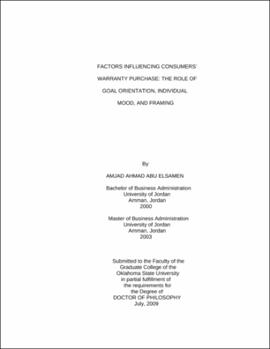| dc.contributor.advisor | Mowen, John C. | |
| dc.contributor.author | Abu Elsamen, Amjad Ahmad | |
| dc.date.accessioned | 2013-11-26T08:25:38Z | |
| dc.date.available | 2013-11-26T08:25:38Z | |
| dc.date.issued | 2009-07 | |
| dc.identifier.uri | https://hdl.handle.net/11244/6812 | |
| dc.description.abstract | Scope and Method of Study: This dissertation investigated how decision framing and an individuals' mood and goal orientation interact to influence the decision to buy a car warranty. In the process, the psychometric properties of a measure of goal orientation developed by Lockwood et al. (2002) were investigated. Two methods were employed in the dissertation. First, a survey approach was employed to assess the psychometric properties of the goal orientation construction. Second, an experimental approach was used to examine the predicted three-way interaction among decision framing, mood, and goal orientation. | |
| dc.description.abstract | Findings and Conclusions: In Study 1,280 undergraduates completed the goal orientation scale (Lockwood et al 2002), which was subjected to confirmatory factor analysis. The results revealed a factor assessing a promotion orientation and a factor assessing a prevention orientation, and that the factors had good discriminant validity. Using the same data, the antecedents and consequences of each factor were investigated. The results showed that the antecedents and consequences of the two factors were different, which strongly suggests that they represent two different constructs rather than dimensions of a single construct. | |
| dc.description.abstract | In Study 2, 246 students participated in an experiment in which the dependent variable was the likelihood of buying a car warranty. In a single study, four variables were investigated in two 2 x 2 x 2 between subjects factorial design. The variables were: (1)whether the respondents were high or low in promotion orientation, (2) whether they were high or low in prevention orientation, (3) whether they were placed in a good or bad mood, and (4) how the warranty purchase was framed (i.e., as a gain or a loss). The expected three-way interaction among mood, decision frame, and promotion orientation was not found. As predicted, however, a significant three-way interaction was found when a maximum fit occurred among mood, decision frame, and prevention orientation. Thus, the likelihood of buying a car warranty decreased when a prevention oriented individual was placed in a sad mood and read a warranty description framed as a loss. Theoretical, managerial, and public policy implications, as well limitations and future directions were discussed. | |
| dc.format | application/pdf | |
| dc.language | en_US | |
| dc.rights | Copyright is held by the author who has granted the Oklahoma State University Library the non-exclusive right to share this material in its institutional repository. Contact Digital Library Services at lib-dls@okstate.edu or 405-744-9161 for the permission policy on the use, reproduction or distribution of this material. | |
| dc.title | Factors influencing consumers' warranty purchase: The role of goal orientation, individual mood, and framing | |
| dc.contributor.committeeMember | Fang, Xiang | |
| dc.contributor.committeeMember | Zablah, Alex R. | |
| dc.contributor.committeeMember | Pappas, James | |
| osu.filename | AbuELSamen_okstate_0664D_10396 | |
| osu.accesstype | Open Access | |
| dc.type.genre | Dissertation | |
| dc.type.material | Text | |
| thesis.degree.discipline | Business Administration | |
| thesis.degree.grantor | Oklahoma State University | |
